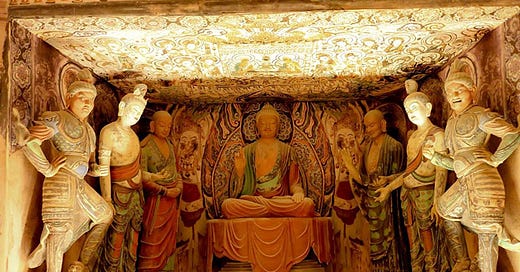TheGentleLaw Community
Chang Dai-Chien (張大千), born in 1899 in Sichuan, China, is regarded as one of the most influential Chinese artists of the 20th century. His artistic journey spanned decades and saw him transform traditional Chinese painting into a vibrant, modern expression. His works, deeply rooted in classical Chinese aesthetics, also broke boundaries, drawing from both Eastern and Western art traditions. One of the most significant influences on his later work was his profound engagement with the art of Dunhuang, which greatly impacted his portrayal of Buddhist themes, particularly the Buddhas that adorn the famous murals of the Mogao Caves.
Chang Dai-Chien’s Artistic Journey
Chang’s upbringing in a wealthy, culturally rich family allowed him to be immersed in the arts from an early age. His training in calligraphy, Chinese ink painting, and seal carving was shaped by the influence of the great Chinese masters, particularly the artists of the Tang and Song dynasties. As a young artist, Chang was drawn to the classical elements of Chinese painting but was never content to merely replicate the past. He sought to bring fresh life to these traditional forms, blending them with modern techniques and ideas.
The Influence of Dunhuang’s Buddhist Art
The ancient Buddhist murals of Dunhuang, located in the Mogao Caves in northwestern China, had long been a source of fascination for Chinese artists. The caves are a treasure trove of Buddhist iconography, featuring stunning depictions of Buddhas, bodhisattvas, and scenes from the Buddhist cosmos, all of which reflect the spiritual and cultural exchanges along the Silk Road. Chang first encountered these murals during a trip to Dunhuang in 1941, where he was deeply moved by their beauty and spiritual power.
The Dunhuang Buddhas, with their serene expressions, elegant poses, and radiant halos, captured Chang’s imagination. They became a central influence in his work, and he dedicated much of his later career to reinterpreting the figures and themes he encountered in the caves. For Chang, the Dunhuang murals represented the pinnacle of Buddhist art, and his admiration for their timeless quality inspired him to create his own unique adaptations.
The Dunhuang Buddhas
Chang’s approach to the Dunhuang Buddhas was not about strict replication but about capturing their essence and spiritual energy while infusing them with his own artistic vision. His renditions of the Buddhas were marked by a blend of traditional Chinese brushwork with a freer, more dynamic style. Chang moved beyond the restrained, meticulous brushstrokes that characterized traditional Chinese ink painting and embraced bold, expressive lines and vivid color palettes that drew on his exposure to Western artistic techniques, such as Impressionism.
In his works, Chang maintained the fundamental iconography of the Dunhuang Buddhas—radiant halos, flowing robes, and meditative poses—but his reinterpretation added new layers of emotion and vitality. He sought to evoke not just the physical forms of the Buddhas but their spiritual presence. His use of vibrant colors and innovative brushwork breathed new life into the ancient figures, making them feel more contemporary and emotionally resonant.
Fusion of Eastern and Western Art Techniques
Chang’s engagement with Dunhuang’s Buddhist art also coincided with his increasing interest in Western art. Having traveled to Europe in the 1930s, he was exposed to the works of European artists, including the vibrant colors of the Impressionists. This exposure to Western techniques, particularly the loose brushstrokes and bold use of color, had a profound influence on Chang’s work. His Dunhuang-inspired paintings, which featured the Buddhas and bodhisattvas, began to combine traditional Chinese brushwork with a more expressive, modern use of color and form. This fusion of Eastern and Western artistic traditions set Chang apart from his contemporaries and established him as a true innovator in the world of Chinese art.
Legacy and Impact of Chang Dai-Chien’s Dunhuang-Inspired Works
The influence of the Dunhuang Buddhas can be seen throughout Chang’s career, particularly in his later works of the 1950s and 1960s, when he created large-scale paintings inspired by the ancient murals. One of his most famous works, The Buddha of the Western Paradise, exemplifies his reinterpretation of the Dunhuang style. The grandeur of the Buddhas is evident in the flowing robes, serene expressions, and luminous halos surrounding the figures. While Chang’s paintings retained the traditional Buddhist iconography, they also showcased his personal artistic voice—vivid, dynamic, and modern.
Through these works, Chang helped to preserve the legacy of Dunhuang’s Buddhist art, making it accessible to a global audience. His ability to reinterpret ancient themes while blending them with modern techniques allowed him to bridge the gap between traditional Chinese painting and the evolving global art scene. In doing so, he ensured that the legacy of Dunhuang would continue to influence generations of artists to come.
Enduring Legacy
Chang Dai-Chien’s work, particularly his reinterpretation of the Dunhuang Buddhas, stands as a monumental achievement in the history of Chinese art. His ability to draw from the spiritual and artistic traditions of the past while embracing modern techniques created a body of work that transcends time and place. Through his depictions of the Dunhuang Buddhas, Chang not only preserved the essence of ancient Chinese art but also ensured that it would continue to resonate with future generations. His artistic legacy remains a testament to the enduring power of creativity, spirituality, and cultural exchange.





